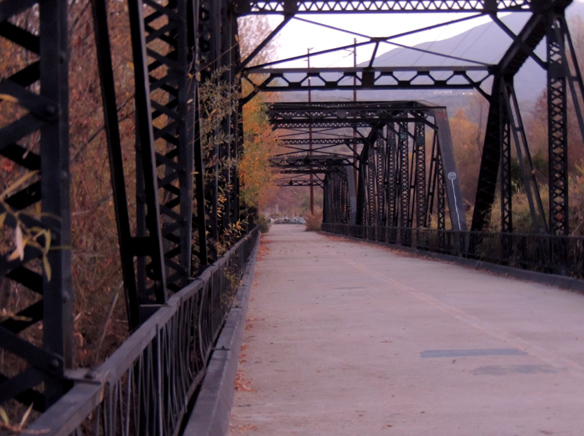I never even knew about the San Diego National Wildlife Refuge until I chanced upon it one day in one of my photo safaris. I had parked next to the Steele Canyon Bridge in Rancho San Diego across from the shopping center. After I shot several photos of the bridge, I ventured on, curious as to what lay beyond.
I never even knew about the San Diego National Wildlife Refuge until I chanced upon it one day in one of my photo safaris. I had parked next to the Steele Canyon Bridge in Rancho San Diego across from the shopping center. After I shot several photos of the bridge, I ventured on, curious as to what lay beyond.
I heard a hoot owl speak his secret language high up in the trees. Almost immediately, I came upon a stately old sycamore tree a hundred feet high. As it was still late winter at the time, its leaves scattered out like a blanket over the grass. Some of them were as big as dinner plates.
After taking pictures of the tree, I walked down the main path. That was when I found the trail marker of the refuge. I have lived in San Diego for 30 years, thought I knew every single spot in these parts, so I felt like I had found gold. I continued on the path for a while, marveling at the huge expanse of land. Mt. Miguel rose up like a sentinel from the valley.
The sky was getting dark fast, so I turned back to my car. The next time I ventured out, it was just a month ago. I was going to park by the old iron bridge again but saw a sign that said no parking after 7 p.m. Not willing to give up, I drove a little further up Highway 94 just past the bridge and turned right on Millars Ranch Road.
Again, it was like a new land I had discovered. Dips and turns in the road revealed an immense rugged land. I kept going until I saw a gate with a sign forbidding shooting on the refuge. There was only one other vehicle parked there and I could hear chickens and roosters at the adjacent farms.
The late afternoon sun streaked across the valley. I saw a tree in the distance and decided to make that my first goal. The trek out to it was quiet except for the chickens carrying on next door. Once at the tree, I saw that the path went a long way around, so I went walking, giving myself half an hour to have the time to turn back as the sun set.
There were rabbits galore. A red-tailed hawk soared overhead, a vulture, too. The trail went on forever and I was getting a little skittish being out there alone.
When I turned around, the sun blinded me, so I kept my head bowed down staying in the shadowy part of the trail. I was deep in thought when I saw something out of the corner of my eye. There within inches of my right foot was a big black tarantula.
Yes, I jumped. Then I laughed with relief because I knew that tarantulas do not harm people. Still, I waited until my heart stopped jangling and my hands jittering before I bent down low to take a photograph. The spider was just so big, and it gave me the heebie-jeebies when it suddenly arched up, lifting one of its front legs. I backed off and watched it amble over to its hiding place under a nearby bush.
My heart was still thumping pretty fast when I heard panting and pounding behind me. Alarmed, I turned to see that it was only a young woman running with her dog. We said hello to each other. I asked what was around the bend in the trail. She showed me pictures of Mt. Miguel and said she lived in the neighborhood.
“It’s big out here,” she said.
Indeed, it is. When it gets a little cooler, I’ll venture out there again. I will give the right of way to that tarantula, though.
Established in 1996, the refuge stretches from Jamul to communities in Spring Valley and eastern Chula Vista. At over 11,152 acres, the refuge is the U.S. Fish and Wildlife Service’s contribution to the Multiple Species Conservation Program (MSCP), a landscape-wide habitat conservation plan to preserve habitat and species while allowing appropriate development.
Currently, the NWR draft CCP and environmental assessment is available for public review and comment until September 17, 2014. Printed versions of the draft are available at Rancho San Diego Library, 11555 Via Rancho San Diego.
Information about San Diego National Wildlife Refuge is found at www.fws.gov/refuge/San_Diego.














